Convalescent, then tuberculosis, chest diseases. Later, geriatric.
On 1st March 1937 the Minister of Health, Sir Kingsley Wood, laid the foundation stone for a home for poor disabled people. The cost of the building - about £60,000 - was borne by Sir Isaac Wilson (1862-1942), who also donated the land, which lay in the grounds of his own home, The Birches, near Mitcham Cricket Green. (Sir Isaac had also financed the Wilson Hospital, which opened in 1928).
However, Sir Isaac and Lady Wilson subsequently offered the building as a gift to Surrey County Council for use as a convalescent home. The offer was accepted in May 1938. Sir Isaac and Lady Wilson became life members of the management committee, along with seven other members appointed by the Council.
The new building, named Cumberland House Hospital, had 110 beds. It was equipped and furnished by the Council, who also appointed the 24 members of staff. Patients were received from the county's other hospitals for convalescent care, staying from 2 to 8 weeks; the first was admitted on 29th March 1939.
The ground floor of the Hospital contained administrative offices, two wards, a dispensary and the kitchens. On the first floor were two wards, an electrical treatment room, living quarters for the doctor, and dining rooms for the nursing and domestic staff. The second floor contained living quarters for the Matron and the Assistant Matron, and 22 bedrooms for nurses and domestic staff; there were also two staff common rooms. The building was equipped with balconies and the grounds were spacious enough for recreation.
During WW2 (1939-1945) the Hospital joined the Emergency Medical Service.After the war the Hospital was primarily used for the treatment of patients with pulmonary tuberculosis.
In 1946, following the death of Sir Isaac Wilson, The Birches, adjacent to the grounds of the Hospital, was acquired for use as staff accommodation. Some £1,320 was allocated by the Council to furnish and equip the property to house a doctor, 6 senior nursing staff and 2 maids.
The Hospital joined the NHS in 1948 under the control of the St Helier Group Hospital Management Committee, part of the South West Metropolitan Regional Hospital Board. It was renamed the Cumberland Hospital. It had 102 beds, and admitted patients in all stages of pulmonary TB except convalescence. However, 20 of the 102 beds were closed due to lack of staff.By 1949 the Hospital had 99 beds.
In 1952 the Hospital was redecorated. Bell pushes at each bed and a new wireless (radio) system were installed. Additional staff WCs were created, but an extension for the X-ray Department was deferred by the Regional Hospital Board because of lack of funds. The nurses' tennis lawn was converted to a hard court.
By 1952 only minor operations were performed at the Hospital. Patients for major surgery were transferred to St Helier Hospital, returning for post-operative care. As the nursing situation improved, one of the closed wards could be re-opened.
A drug trial on isonicotinic acid hydrazide was instituted by the Medical Research Council.
The weekly cost of an in-patient in 1952 was £11 2s 5d (£11.12).
In 1957 the Hospital had a bed occupancy of 70%, until 28 cases were transferred from the Grove Hospital.
In March 1959 the laboratory work was transferred to the new Laboratory at the Wilson Hospital.
A new Chest Clinic and X-ray Department had been built and were officially opened on 10th July 1959 by Mrs A.G. Linfield, the wife of the Chairman of the South West Metropolitan Regional Hospital Board. The Hospital had 100 beds and now, as well as those with TB, admitted patients who were suffering from other chest diseases, some of whom were very ill.
In 1959 the weekly cost of an in-patient was £18 19s 2d (£18.96), compared to £15 19s 1d (£15.95) in the previous year.
By 1965 the weekly cost of an in-patient had increased to £32 5s 1d (£32.25) and to £34 1s 0d (£34.05) by 1966.
In 1966 The Birches became the Sisters' Home. The Hospital had 100 beds, of which 87 were staffed.
In 1970 the weekly cost of an in-patient was £62.96, rising to £67.78 in 1971.
Following a major reorganisation of the NHS in 1974, the Hospital came under the control of the Sutton and West Merton District Health Authority, part of the South West Thames Regional Health Authority. It began to admit geriatric patients as well as those with chest diseases. In 1976 it had 48 beds for chest patients and 16 beds for geriatric cases.
On 10th September 1979 the consultant chest physician discovered that the Regional Health Authority proposed to close the Hospital by the end of November. A petition was organised by the local community to protest against this, especially as the Health Authority had spent large sums of money on redecoration, re-wiring, double-glazing and other improvements to the building earlier in the year. Over 17,000 signatures were collected and presented to No. 10 Downing Street by nurses from the Hospital.
Despite this great public protest, the Hospital closed 'temporarily' on 30th November 1979 in order to save money. It never re-opened.
Present status (June 2008)
The Hospital building was demolished in 1992 and its site is now occupied by the Cumberland Care Home for patients with Alzheimer's disease and dementia, and the Cumberland Day Centre, which was opened by Baroness Wilson of Rievaulx in 1996.
Only the gateway and the walls remain.
Update: May 2016
The Cumberland Day Centre closed in April 2013 following withdrawal of funding by Merton Council. The building has now become the Merton Dementia Hub.
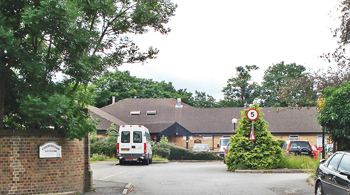
The main entrance is through the original gateway.
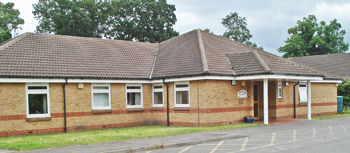
The Cumberland Day Centre is at the front of the site.
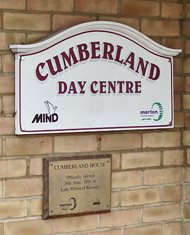
A plaque by the entrance to the building commemorates its official opening by Lady Wilson.
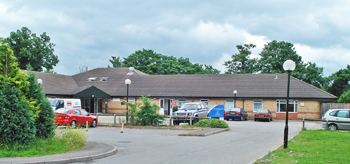
The Cumberland Care Home is at the back of the site.
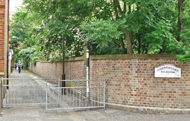
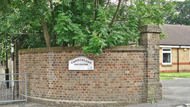
The original wall and gate posts of the Cumberland Hospital have been retained.
http://hansard.millbanksystems.com
http://photoarchive.merton.gov.uk (1)
http://photoarchive.merton.gov.uk (2)
https://collage.cityoflondon.gov.uk
https://mitchamhistorynotes.wordpress.com
https://photoarchive.merton.gov.uk (1)
https://photoarchive.merton.gov.uk (2)
https://photoarchive.merton.gov.uk (3)
www.mertonhistoricalsociety.org.uk
Return to home page